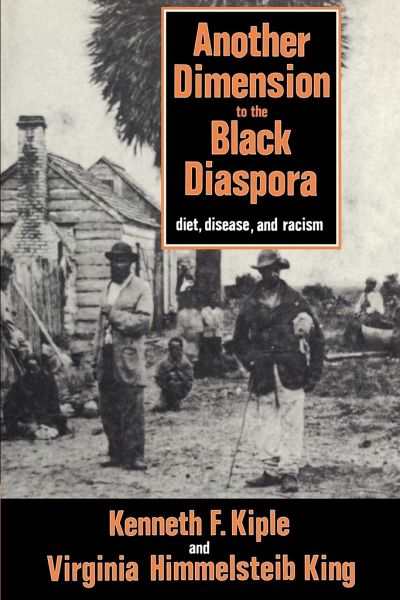
Another Dimension to the Black Diaspora
Diet, Disease and Racism
Versandkostenfrei!
Versandfertig in 1-2 Wochen
40,99 €
inkl. MwSt.

PAYBACK Punkte
20 °P sammeln!
A study of black disease immunities and susceptibilities and their impact on slavery and racism.This is an engrossing study of black disease immunities and susceptibilities and their heretofore unrealized impact on both slavery and racism. Its pages interweave the nutritional, biological, and medical sciences with demography. The book begins with an examination of the preslavery era in Africa and then pursues its subject into the slave societies of the West Indies and the United States. This truly interdisciplinary approach permits the blending of two distinctive concepts of racial differences...
A study of black disease immunities and susceptibilities and their impact on slavery and racism.
This is an engrossing study of black disease immunities and susceptibilities and their heretofore unrealized impact on both slavery and racism. Its pages interweave the nutritional, biological, and medical sciences with demography. The book begins with an examination of the preslavery era in Africa and then pursues its subject into the slave societies of the West Indies and the United States. This truly interdisciplinary approach permits the blending of two distinctive concepts of racial differences, that of the hard sciences based on gene frequencies and that of the social sciences stressing environmental factors. The authors investigate black health and white medical practice in the United States during the antebellum period, and establish a link between black-related diseases and white racism. A final section traces major black disease susceptibilities from the Civil War to the present, arguing that the different nutritional and medical needs of blacks are still largely unappreciated or ignored.
Table of content:
Preface; Acknowledgements; Part I. African Beginnings: Introduction to part I; 1. The black man's cradle and the white man's grave; Part II. Immunities: Epidemiology and the Slave Trade: Introduction to part II; 2. Yellow fever in black and white; 3. Bad air in a new world; 4. Tropical killers, race and the peculiar institution; Part III. Susceptibilities: Introduction to part III; 5. 'Negro diseases': an introductory glimpse; 6. Nutrients and nutriments; 7. The children; 8. Aliments and ailments; 9. Selection for infection; 10. Cholera and race; Part IV. Antebellum Medicine: Introduction to part IV; 11. Slave medicine; 12. Physicians versus the slaves; Part V. Sequelae and Legacy: Introduction to part V; 13. Epilogue: cradle to grave; Notes; Bibliographic essay; Index.
This is an engrossing study of black disease immunities and susceptibilities and their heretofore unrealized impact on both slavery and racism. Its pages interweave the nutritional, biological, and medical sciences with demography. The book begins with an examination of the preslavery era in Africa and then pursues its subject into the slave societies of the West Indies and the United States. This truly interdisciplinary approach permits the blending of two distinctive concepts of racial differences, that of the hard sciences based on gene frequencies and that of the social sciences stressing environmental factors. The authors investigate black health and white medical practice in the United States during the antebellum period, and establish a link between black-related diseases and white racism. A final section traces major black disease susceptibilities from the Civil War to the present, arguing that the different nutritional and medical needs of blacks are still largely unappreciated or ignored.
Table of content:
Preface; Acknowledgements; Part I. African Beginnings: Introduction to part I; 1. The black man's cradle and the white man's grave; Part II. Immunities: Epidemiology and the Slave Trade: Introduction to part II; 2. Yellow fever in black and white; 3. Bad air in a new world; 4. Tropical killers, race and the peculiar institution; Part III. Susceptibilities: Introduction to part III; 5. 'Negro diseases': an introductory glimpse; 6. Nutrients and nutriments; 7. The children; 8. Aliments and ailments; 9. Selection for infection; 10. Cholera and race; Part IV. Antebellum Medicine: Introduction to part IV; 11. Slave medicine; 12. Physicians versus the slaves; Part V. Sequelae and Legacy: Introduction to part V; 13. Epilogue: cradle to grave; Notes; Bibliographic essay; Index.




